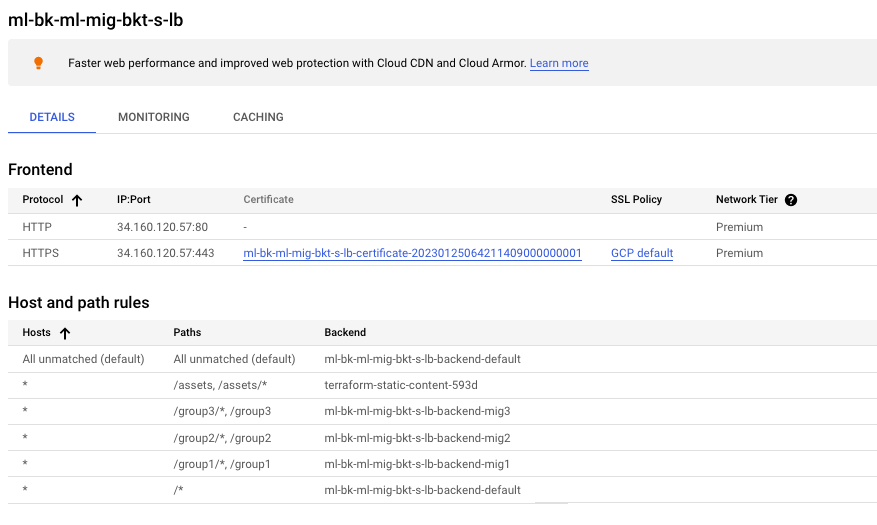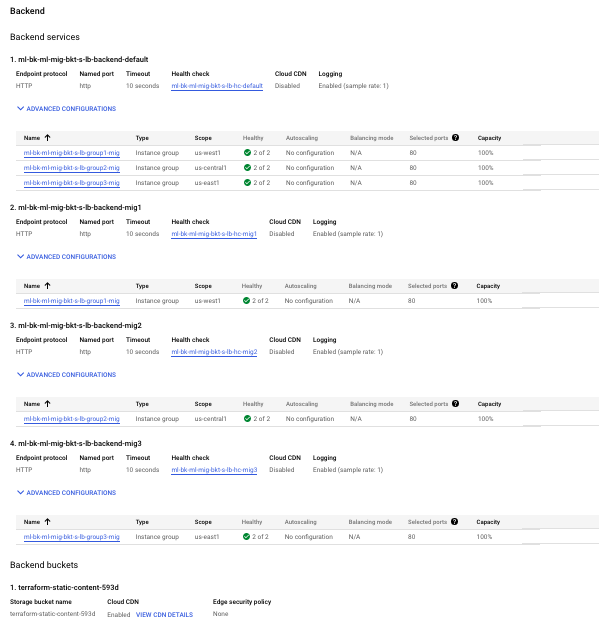Checkpoints
Apply the changes in Terraform
/ 100
HTTPS Content-Based Load Balancer with Terraform
GSP206
Overview
In this lab, you will create an HTTPS load balancer to forward traffic to a custom URL map. The URL map sends traffic to the region closest to you with static assets being served from a Cloud Storage bucket. The TLS key and certificate is generated by Terraform using the TLS provider.
The following is a diagram of the architecture you will be creating:
Objectives
In this lab, you will:
- Learn about the load balancing modules for Terraform
- Configure Terraform in the Google Cloud environment
- Create a global HTTPS Content-Based Load Balancer
Setup and requirements
Before you click the Start Lab button
Read these instructions. Labs are timed and you cannot pause them. The timer, which starts when you click Start Lab, shows how long Google Cloud resources will be made available to you.
This hands-on lab lets you do the lab activities yourself in a real cloud environment, not in a simulation or demo environment. It does so by giving you new, temporary credentials that you use to sign in and access Google Cloud for the duration of the lab.
To complete this lab, you need:
- Access to a standard internet browser (Chrome browser recommended).
- Time to complete the lab---remember, once you start, you cannot pause a lab.
How to start your lab and sign in to the Google Cloud console
-
Click the Start Lab button. If you need to pay for the lab, a pop-up opens for you to select your payment method. On the left is the Lab Details panel with the following:
- The Open Google Cloud console button
- Time remaining
- The temporary credentials that you must use for this lab
- Other information, if needed, to step through this lab
-
Click Open Google Cloud console (or right-click and select Open Link in Incognito Window if you are running the Chrome browser).
The lab spins up resources, and then opens another tab that shows the Sign in page.
Tip: Arrange the tabs in separate windows, side-by-side.
Note: If you see the Choose an account dialog, click Use Another Account. -
If necessary, copy the Username below and paste it into the Sign in dialog.
{{{user_0.username | "Username"}}} You can also find the Username in the Lab Details panel.
-
Click Next.
-
Copy the Password below and paste it into the Welcome dialog.
{{{user_0.password | "Password"}}} You can also find the Password in the Lab Details panel.
-
Click Next.
Important: You must use the credentials the lab provides you. Do not use your Google Cloud account credentials. Note: Using your own Google Cloud account for this lab may incur extra charges. -
Click through the subsequent pages:
- Accept the terms and conditions.
- Do not add recovery options or two-factor authentication (because this is a temporary account).
- Do not sign up for free trials.
After a few moments, the Google Cloud console opens in this tab.

Activate Cloud Shell
Cloud Shell is a virtual machine that is loaded with development tools. It offers a persistent 5GB home directory and runs on the Google Cloud. Cloud Shell provides command-line access to your Google Cloud resources.
- Click Activate Cloud Shell
at the top of the Google Cloud console.
When you are connected, you are already authenticated, and the project is set to your Project_ID,
gcloud is the command-line tool for Google Cloud. It comes pre-installed on Cloud Shell and supports tab-completion.
- (Optional) You can list the active account name with this command:
- Click Authorize.
Output:
- (Optional) You can list the project ID with this command:
Output:
gcloud, in Google Cloud, refer to the gcloud CLI overview guide.
Task 1. Clone the sample repository
- In Cloud Shell, clone the
terraform-google-lb-httprepository:
- Navigate to the
multi-backend-multi-mig-bucket-https-lbdirectory:
-
On the Cloud Shell toolbar, click the Open Editor icon.
-
Open the file
examples/multi-backend-multi-mig-bucket-https-lb/main.tf. -
On line 133, inside the
gce-lb-httpsmodule, add the following lines:
- In the
examples/multi-backend-multi-mig-bucket-https-lb/variables.tffile, update the region definitions to the following:-
group1_region =
-
group2_region =
-
group3_region =
-
group1_region =
Task 2. Run Terraform
Initialize a working directory
The terraform init command is used to initialize a working directory containing Terraform configuration files. This command performs several different initialization steps to prepare a working directory for use. This command is always safe to run multiple times, to bring the working directory up to date with changes in the configuration.
- Run the command:
Example output:
Create an execution plan
The terraform plan command is used to create an execution plan. Terraform performs a refresh, unless explicitly disabled, and then determines what actions are necessary to achieve the desired state specified in the configuration files.
This command is a convenient way to check whether the execution plan for a set of changes matches your expectations without making any changes to real resources or the state. For example, terraform plan might be run before committing a change to version control, to create confidence that it will behave as expected.
- Run the following command to create an execution plan:
Example output:
The optional -out argument can be used to save the generated plan to a file for later execution with terraform apply.
- List out current directory content. You will see the saved Terraform plan (
tfplan):
Example output:
Apply the changes
The terraform apply command is used to apply the changes required to reach the desired state of the configuration, or the pre-determined set of actions generated by a terraform plan execution plan.
- Apply the Terraform plan:
Example output (yours will differ):
Verify the resources created by Terraform:
-
In the Navigation menu navigate to Network services > Load Balancing.
-
Wait until you see the green checkmark in the Backends column.
-
Click on ml-bk-ml-mig-bkt-s-lb load balancer and check the details.
- Run the following to get the external URL:
- Click on the
EXTERNAL_IPlink that is returned to open the load balancer URL in a new browser tab. It will take a few minutes to load.
You should see the Google Cloud logo and instance details from the group closest to your geographical region.
Click Check my progress to verify the objective.
- Now append the URL with
group1,group2andgroup3.
Your final URLs should look like (make sure to replace EXTERNAL_IP with your load balancer IP):https://EXTERNAL_IP/group1
- For
group1: You should see the Google Cloud logo and instance details from the group in.
https://EXTERNAL_IP/group2
- For
group2: You should see the Google Cloud logo and instance details from the group in
https://EXTERNAL_IP/group3
- For
group3: You should see the Google Cloud logo and instance details from the group in
Congratulations!
In this lab, you learned how to configure load balancing modules in Terraform. You then used the modules to create a global HTTPS Content-Based Load Balancer, and used it to test its response to the group closest to your geographical region.
Next steps / learn more
Google Cloud training and certification
...helps you make the most of Google Cloud technologies. Our classes include technical skills and best practices to help you get up to speed quickly and continue your learning journey. We offer fundamental to advanced level training, with on-demand, live, and virtual options to suit your busy schedule. Certifications help you validate and prove your skill and expertise in Google Cloud technologies.
Manual Last Updated December 8, 2023
Lab Last Tested December 8, 2023
Copyright 2024 Google LLC All rights reserved. Google and the Google logo are trademarks of Google LLC. All other company and product names may be trademarks of the respective companies with which they are associated.




